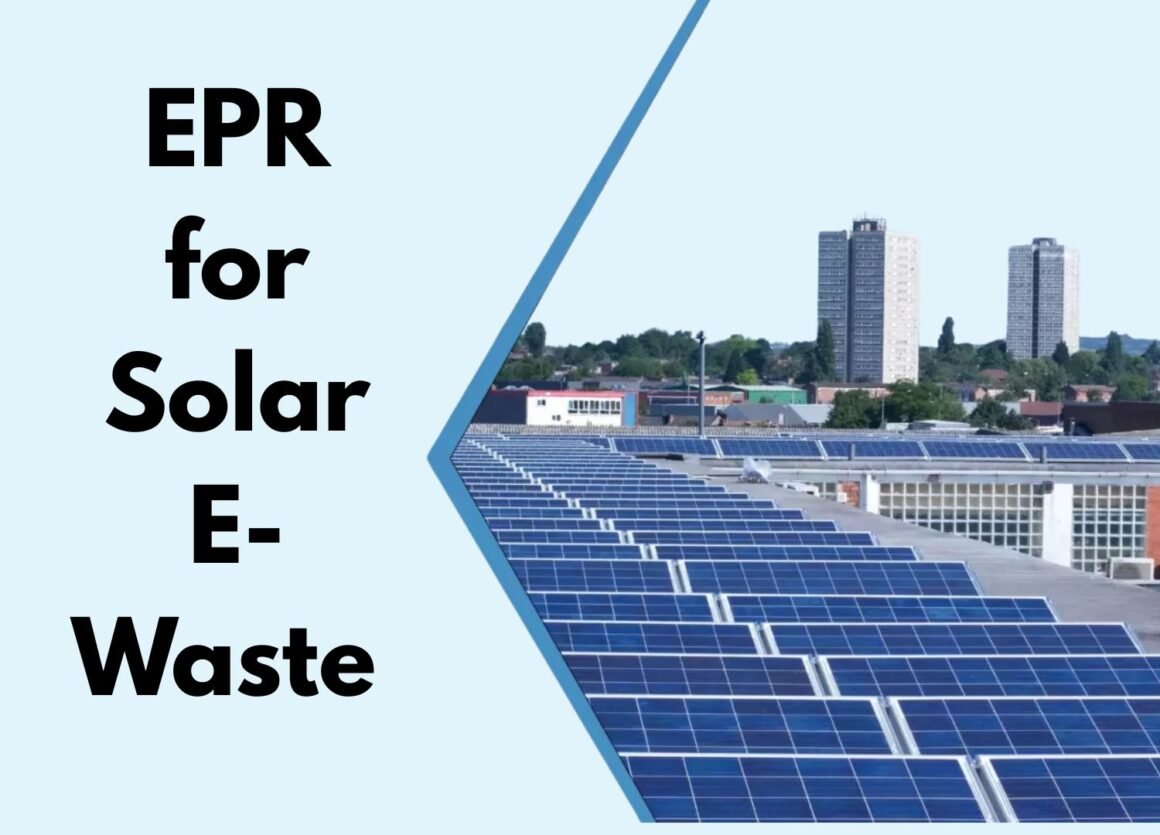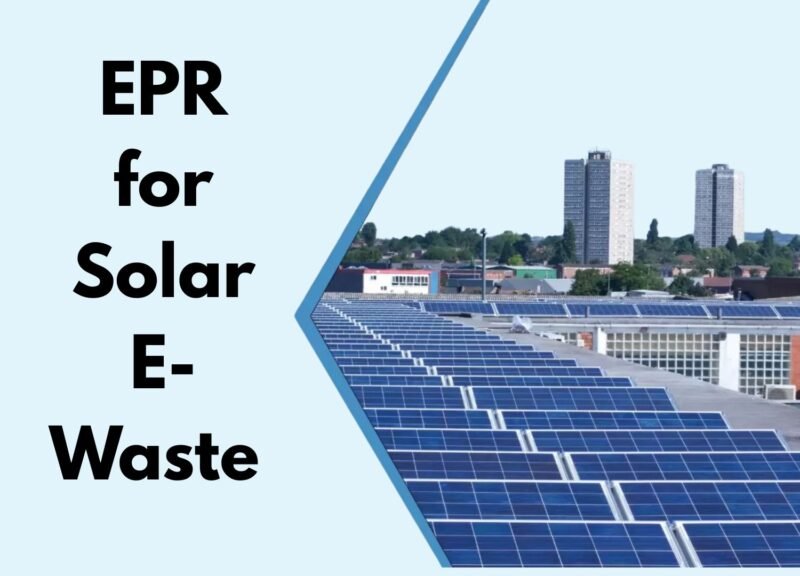EPR for Solar E-Waste – India’s solar success story now faces its toughest test: managing the e-waste of a green revolution.
The global renewable energy revolution has placed solar power at the centre of sustainability. With over 100 GW of installed solar capacity, India is one of the world’s top solar energy producers. However, an emerging problem is beginning to shadow this success — solar e-waste. As millions of solar panels approach the end of their 25-year lifecycle, the question arises: how will India manage this new form of electronic waste?

While the E-Waste (Management) Rules, 2022 have brought solar PV modules, cells, and panels within the e-waste framework, their implementation through Extended Producer Responsibility (EPR) remains complex. Solar e-waste management is not just a regulatory issue — it’s an environmental, logistical, and economic challenge that will define the next phase of India’s green transition.
The Rising Tide of Solar Waste
Solar panels are designed to last for decades, but even the best degrade over time. By 2030, India is expected to generate over 340,000 tonnes of solar waste, growing to 600,000 tonnes by 2040, according to the Central Pollution Control Board (CPCB). Globally, the International Renewable Energy Agency (IRENA) estimates that solar panel waste could exceed 80 million tonnes by 2050.
Solar panels are primarily made of glass (around 70–80%), aluminum frames, silicon, silver, and polymers. While these materials can be recovered and recycled, improper disposal can release hazardous substances such as lead, cadmium, and antimony into the environment.
EPR and Solar E-Waste: Understanding the Framework
Extended Producer Responsibility (EPR) makes producers responsible for the lifecycle of their products, including collection and recycling at end-of-life. Under India’s E-Waste (Management) Rules, 2022, solar PV modules are officially classified as e-waste. This means manufacturers and importers must register with the CPCB, report waste generated, and ensure environmentally sound recycling.
However, in practice, solar e-waste management faces several unique hurdles:
- Delayed Waste Generation: Solar panels have a lifespan of 20–25 years, so significant waste volumes will emerge only after 2035.
- High Recycling Costs: The economic value recovered from panels often doesn’t offset the cost of collection and processing.
- Technical Barriers: Recycling solar panels requires specialized facilities capable of handling glass-metal composites without releasing toxins.
- Limited Infrastructure: India currently lacks sufficient dedicated solar recycling units.
- Weak Enforcement: While the rules exist, monitoring compliance across thousands of installations remains a major challenge.
India’s Current Solar E-Waste Policy Landscape
- The E-Waste Rules 2022 include solar PV modules, cells, and panels in the e-waste category, making manufacturers responsible for their disposal.
- However, solar producers have been temporarily exempted from EPR targets until 2034–35 to allow time for developing recycling capacity.
- The CPCB has issued draft guidelines requiring safe storage, dismantling, and recycling of solar modules. Open dumping or landfill disposal is prohibited.
- Companies must maintain records, submit annual returns, and ensure authorized recyclers handle all waste materials.
These are strong first steps — but without robust implementation, India risks repeating the same mistakes made with general e-waste.
Global Lessons in EPR for Solar E-Waste
- European Union (EU): The WEEE Directive includes solar panels as e-waste, mandating that producers fund collection and recycling. Some EU countries have achieved recovery rates exceeding 90% through specialized facilities.
- Japan: The country’s Home Appliance Recycling Law has been expanded to include solar modules. Producers pay fees that support recycling infrastructure.
- United States: States like California have introduced take-back programs, with manufacturers funding recycling operations.
- Australia: The government’s Product Stewardship Act includes solar waste as a priority stream, encouraging producer-funded recycling and innovation.
Key Takeaway: Global success lies in early policy planning, clear recycling targets, and strong producer accountability
Challenges Ahead for India: EPR for Solar E-Waste
- Economic Viability: Recycling costs exceed material recovery value, discouraging private investment.
- Collection Logistics: Solar installations are widely dispersed, especially in rural areas, making reverse logistics difficult.
- Lack of Technology: Few Indian recyclers possess the expertise to dismantle PV modules safely.
- Informal Sector Threat: Without proper monitoring, untrained workers could handle solar waste, leading to contamination.
- Awareness Gap: Many producers and consumers remain unaware of their EPR responsibilities.
The Way Forward: Building a Circular Solar Economy
- Establish Dedicated Recycling Hubs: Develop region-specific solar recycling facilities equipped with mechanical and chemical separation technologies.
- Incentivize Compliance: Provide tax breaks and EPR credits to companies that exceed recycling targets.
- Strengthen Regulations: Mandate producer take-back programs by 2030 with clear annual targets.
- Promote R&D: Fund innovations in low-cost, high-recovery recycling technologies.
- Integrate Informal Workers: Train and certify small recyclers to prevent unsafe practices.
- Public Awareness Campaigns: Educate consumers and solar developers on sustainable disposal.
- International Collaboration: Partner with EU and Japan to share best practices and technologies.
Conclusion: EPR for Solar E-Waste
EPR for Solar E-Waste represents both progress and responsibility. As the nation transitions to clean energy, it must ensure that its green ambitions don’t create a new environmental crisis. Implementing EPR for solar e-waste is not merely about compliance — it’s about shaping a truly circular economy where sustainability spans the product lifecycle.
By investing now in solar recycling infrastructure, technology, and enforcement, India can become a global model for sustainable renewable energy management — turning today’s challenge into tomorrow’s opportunity.
FOR MORE BLOGS – beyondthepunchlines.com

 Add to favorites
Add to favorites







